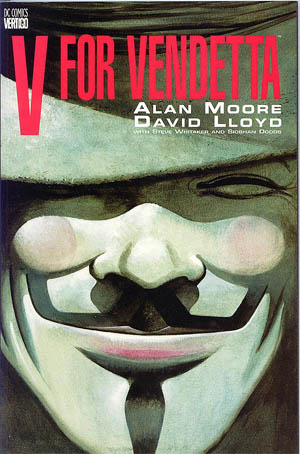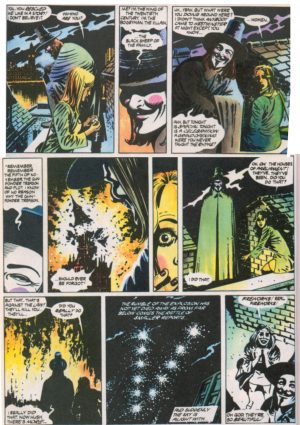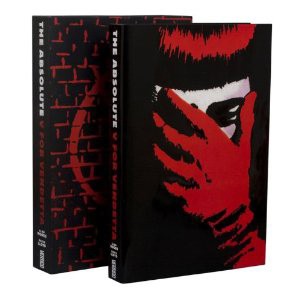Review by Roy Boyd
Whenever anyone is making a case for comics not being just for children, the examples usually given are The Dark Knight Returns, Watchmen, Maus and V for Vendetta. They appeared within a few years of each other, in the late 1980s, and seemed to herald a glorious new age for comics, and their chance of being taken seriously by mainstream audiences and critics. Sadly, that new age never really materialised. It’s noteworthy that Alan Moore wrote two of the books often trotted out as exemplars of the craft, and many more since, some of them more polished and mature, but few more enjoyable.
It’s 1997, and Great Britain, having opted out of the nuclear arms race, has survived a war that has laid waste to many other countries, including the USA. In the nuclear winter that follows the fascist Norsefire party rise to power and establish a brutal police state. Into this arena step our two protagonists as they prepare, separately, to go out for the evening. Evey Hammond is a sixteen-year-old girl who, impoverished and desperate, is about to embark on a career in prostitution, and V is an anarchist freedom fighter/terrorist with a taste for the theatrical, who dresses as Guy Fawkes (if Guy Fawkes had carried daggers and smoke bombs) and is just as happy quoting Enid Blyton as he is Shakespeare.
Evey makes the mistake of soliciting a member of the Finger, the secret police, and is only saved by the timely interruption of V, who goes through the handful of thugs like a hot knife through butter, killing three and leaving the others stunned. Then he blows up the Houses of Parliament. This all takes place within the first six pages, and sets the tone for much of the book, as V trains Evey to be his replacement, and systematically and ruthlessly attacks the corrupt regime in charge, destroying some of their beloved monuments and disabling their omnipresent surveillance apparatus.
David Lloyd, who requested that Moore work with him on the strip, was tired of research after his work on Night Raven, and had balked at the 1930s setting they originally considered, instead opting for the then near-future of the 1990s. Lloyd also suggested working without captions, thought bubbles or sound effects. Coupled with V’s constantly grinning visage, this imbues many scenes with a genuinely creepy quality. The artwork isn’t flashy, but it is very accomplished, with the book reading like a 1930s noir movie, but with the brutality of gritty crime thriller such as The Long Good Friday.
Moore’s writing is, as always, as about as good as it gets in comics, and this book is just bursting with youthful enthusiasm and inventiveness. It also rewards multiple readings, with new apsects to be discovered and admired each time. Like his League of Extraordinary Gentlemen, Moore has taken what is effectively a superhero story and put enough spin on to make it feel like something else entirely. One would hope that the dystopian view of the future this book presented would seem laughable so many years later. Sadly, that is not the case, and the story resonates now even more than when it was produced. Timeless, and there’s now also a hardover, slipcased Absolute edition as well.




